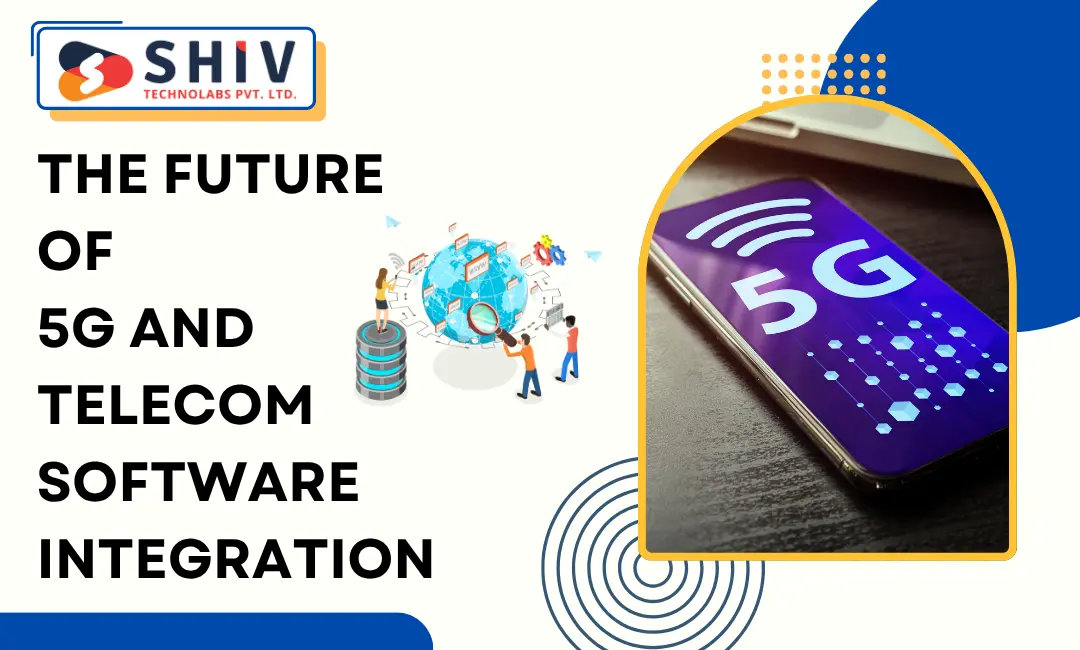
The global telecom industry is entering a new phase with the rise of 5G networks. Fast connections, ultra-low latency, and software-driven systems are reshaping communication technology. Every Telecom Software Development Company now works to build systems that can handle these demands.
Businesses and users expect instant communication, high-quality streaming, and smart device connectivity. Meeting these needs requires tight coordination between hardware, networks, and software systems. Telecom software integration is now at the heart of this revolution.
What Makes 5G a Turning Point for Telecom
5G is not only faster than 4G; it represents a complete shift in network design. Telecom operators can now manage large data transfers, IoT devices, and remote operations with better accuracy and reliability.
1. Speed and Reliability
5G delivers faster transmission speeds and minimal delays. This means smoother video calls, instant downloads, and real-time communication between connected devices. Telecom networks can support millions of sensors, cameras, and IoT systems without delay.
2. Support for Smart Systems
Industries such as healthcare, logistics, and automotive depend on stable connectivity. Smart vehicles, connected factories, and remote surgeries need consistent performance. 5G provides that reliability and makes large-scale automation possible.
3. New Possibilities for Telecom Operators
Telecom companies can offer more than just voice and data. With 5G, they can deliver advanced enterprise solutions, such as private networks, IoT platforms, and real-time analytics. That’s where Telecom Software Development Services play a critical role.
Why Software Integration Is Vital in the 5G Era

Telecom networks are now software-defined. This means they run on code that controls devices, data routing, and service delivery. Integrating telecom software across various systems allows faster operations, lower costs, and stronger data security.
1. Defining Telecom Software Integration
Telecom software integration connects different network components, including billing systems, subscriber databases, and communication tools. It helps providers manage services, monitor network traffic, and deliver new updates without long downtimes.
For example, a telecom operator might use one platform for billing and another for customer management. Integration brings these together into a single interface, improving accuracy and response time.
2. Managing Complex Network Systems
5G networks involve multiple layers — core, edge, and cloud. Integration allows these layers to communicate smoothly. Telecom companies can add or modify services faster without redesigning the entire system.
3. Role of Automation and Artificial Intelligence
Modern Telecom Software Development Services include AI-based automation. It helps monitor traffic patterns, detect faults, and make predictive decisions before failures occur. Automation reduces manual work and improves service uptime.
4. Cloud-Native Infrastructure
Cloud technology plays a major part in 5G software integration. Applications built with microservices and APIs can run anywhere — on private clouds, public platforms, or edge devices. This flexibility lets telecom firms adapt faster to growing demand.
Also read: Telecom Billing Software: Guide to Costs, Technologies, and Business Impact
Key Technologies Driving 5G and Telecom Software Integration

The shift toward software-driven networks depends on several advanced technologies. Each supports scalability, real-time analytics, and reliable data processing.
1. Software-Defined Networking (SDN) and Network Function Virtualization (NFV)
SDN separates network control from physical hardware. NFV replaces traditional network devices with software applications that perform the same functions. Together, they allow telecom providers to manage networks more efficiently.
This setup also lowers hardware costs and reduces the time required to introduce new services. A well-built system by a Telecom Software Development Company can update or replace functions without downtime.
2. Edge Computing for Faster Data Access
Edge computing processes data near the user’s location instead of sending everything to a central server. It cuts delay and improves response speed, which is vital for real-time services like video streaming or autonomous driving.
Telecom software integration helps connect edge systems with central networks, maintaining security and control while reducing latency.
3. Artificial Intelligence and Machine Learning
AI in telecom helps detect network failures, balance loads, and predict customer behavior. Machine learning algorithms study usage trends and adjust performance automatically. This data-driven approach improves network stability and reduces operational costs.
4. Internet of Things (IoT) and Device Connectivity
Billions of IoT devices will depend on 5G for constant communication. Telecom software integration connects these devices to central systems while maintaining performance and safety. From home automation to industrial IoT, 5G will enable faster coordination across all sectors.
Also read: Custom Software Development: The Key to Digital Transformation
Future Trends in 5G and Telecom Software Development
The telecom industry is constantly evolving. Several emerging trends will shape how software integration grows in the coming decade.
1. Rise of Open RAN (O-RAN)
Open RAN allows telecom providers to use components from different vendors. It promotes flexibility and reduces dependency on a single hardware manufacturer. Software integration becomes essential to make all these parts work together.
A skilled Telecom Software Development Company can build interfaces that connect various vendors’ systems without performance loss.
2. Self-Organizing Networks (SON)
SON technology uses automation to manage, repair, and improve networks. These networks can identify problems, adjust configurations, and maintain quality without manual input. It leads to fewer interruptions and higher customer satisfaction.
3. Advanced Security Protocols
5G’s wider connectivity surface means more security challenges. Telecom software developers are introducing new authentication methods, AI-based threat detection, and encryption systems to protect sensitive data.
Integration between security layers is critical. When different applications share threat data instantly, they can stop attacks before they spread.
4. Integration with Cloud-Native and API-First Models
Telecom services now follow API-first development, allowing faster upgrades and real-time data exchange between systems. Cloud-native applications allow telecom companies to launch or modify services quickly with fewer errors.
5. The Move Toward Automation and Self-Healing Networks
Automation and AI are reducing manual processes in network management. Future networks will correct themselves when errors occur. This improves stability and allows telecom companies to focus on innovation rather than repair.
Business Benefits of Telecom Software Integration
Telecom software integration not only supports 5G technology but also brings measurable business benefits.
1. Faster Time to Market
Integrated systems help telecom operators launch new services faster. Instead of waiting months for manual testing, automated integrations allow updates within days.
2. Lower Operational Costs
Automation, virtualization, and cloud management reduce hardware costs and staff requirements. Telecom companies can focus resources on growth rather than maintenance.
3. Better Customer Experience
When systems share information smoothly, customers enjoy better service quality. Calls connect faster, payments process instantly, and support teams resolve issues quickly.
4. Improved Data Management
Integrated software collects data from multiple touchpoints. Telecom companies can study this data to predict demand, identify network issues, and make smart investment decisions.
Also read: How Blockchain Software Transforms Fintech Solutions
How Businesses Can Prepare for 5G Software Integration
Companies must upgrade their telecom infrastructure to take full advantage of 5G. The following steps can help them prepare for this transformation:
1. Audit current systems – Identify outdated software and hardware that may block 5G upgrades.
2. Adopt modular designs – Modular systems make future expansion easier.
3. Use API-based integration – APIs allow different tools to communicate efficiently.
4. Partner with experienced developers – Collaborating with a skilled Telecom Software Development Company ensures safe migration and long-term scalability.
Partner With Shiv Technolabs for Future-Ready Telecom Software Solutions
Shiv Technolabs delivers advanced Telecom Software Development Services designed to meet the demands of the 5G era. Our team builds intelligent, high-performance systems that strengthen connectivity, automate workflows, and improve scalability for global telecom operators.
We design, integrate, and maintain robust telecom platforms that support next-generation technologies. Businesses rely on us for precision, reliability, and long-term success.
Our Telecom Software Solutions Cover:
- Custom 5G network application development
- Cloud-native and API-based integration systems
- AI-powered network automation and monitoring
- Secure, modular telecom management platforms
- Continuous support and performance optimization
Our experienced developers combine technical skill with strategic planning to deliver software that meets your network and customer needs.
Ready to start your 5G transformation journey? Contact us to discuss your telecom software development goals and find the right solution for your business.
Conclusion
The integration of 5G and telecom software defines the next phase of network evolution. Future-ready systems must support dynamic network slicing, real-time analytics, and multi-access edge computing. A modern Telecom Software Development Company focuses on building microservice-based architectures that improve scalability and reduce downtime.
Advanced Telecom Software Development Services include AI-driven monitoring, container orchestration, and secure APIs that link distributed environments. With these capabilities, telecom providers can deliver faster, smarter, and more reliable network operations that align with the speed and complexity of 5G technology.
Start writing here...